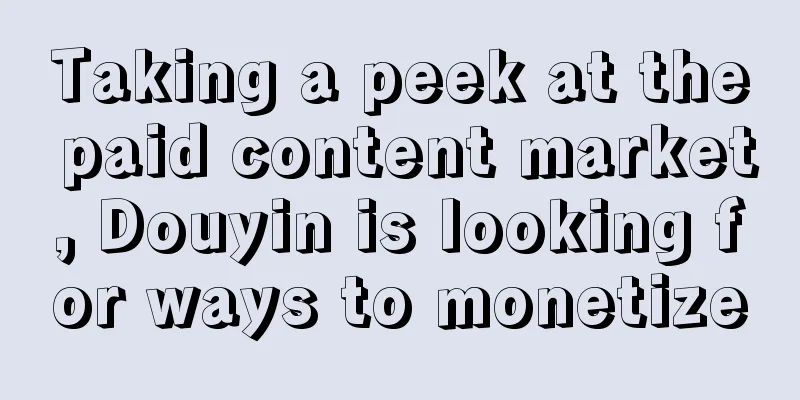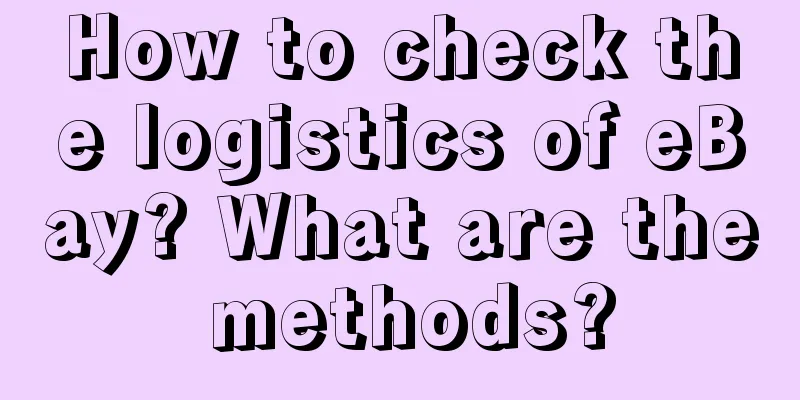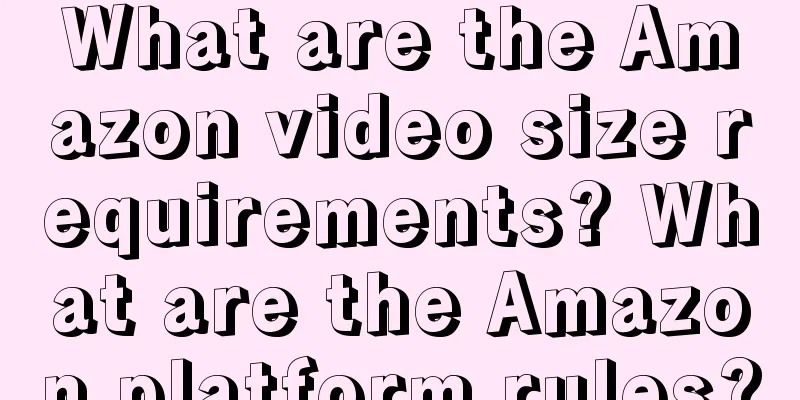Taking a peek at the paid content market, Douyin is looking for ways to monetize

Will watching short videos cost money? Netizens exclaimed: Great, just in time to quit. Recently, some users have discovered that when watching some videos on Douyin, they need to pay to unlock all the content. The topic #TikTok tests paid short videos# quickly became a hot topic and has been read over 200 million times so far. Judging from the comments, most users are opposed to this move. Putting aside the emotional catharsis of users, from the perspective of business model, domestic long video payment has gone through a long period of time and has gradually been accepted by people, but short videos are just getting started. For the form of short videos, what experience can other content payment platforms learn from? 1. Douyin cannot catch up with knowledge paymentContent payment focuses on two cores: providing information or emotions and bringing value to users. Therefore, when Douyin launched content payment, many people commented that "knowledge payment is more acceptable", after all, knowledge is generally considered valuable information. This can't help but remind people of the title of "Internet Night School" that Douyin was awarded some time ago. That is, after work, people can find interesting knowledge videos on the Douyin platform to "recharge" themselves. Douyin plays the role of a knowledge dissemination platform here. Various types of knowledge short videos have flourished, thanks to Douyin's continued development. With the dual support of the platform and the publicity of universities, last year the coverage rate of open courses in double first-class universities increased to 93.2%, and the coverage rate of first-level disciplines was 100%. According to the "2023 Douyin Open Course Learning Data Report", domestic universities have accumulated 10,000 live broadcasts on Douyin in 2022, with a total duration of more than 73.5 million minutes, equivalent to 16,800 classes. A total of 400 professors, 45 academicians, and 4 Nobel Prize winners have imparted knowledge on Douyin. As a national platform with 800 million daily active users, Douyin has been producing popular science content for a long time. Since 2018, the official account of the China Science and Technology Museum, "Magic Laboratory", "Physics Teacher Lei" who specializes in physics, "Dai Jianye", a professor of Chinese Department who teaches Tang and Song poetry, and "Daodao Wei", a professor of Peking University who specializes in psychology, have successively flocked to Douyin. Surprisingly, Douyin users also prefer knowledge-based content. According to Douyin's official data for that year, the average number of views, likes, shares, and average number of fans of knowledge-based authors were much higher than those of other types. Judging from the overall data, Douyin's knowledge payment has its own content and user base. Enabling the paid video function can not only charge a 30% service fee and increase platform revenue, but also open up new monetization methods for creators who are not so adaptable to live broadcasts, advertising and other forms. Despite this, people still position Douyin as an entertainment platform, and it remains to be seen whether users are willing to pay for short science videos. A history science blogger with two million followers on Douyin saw his average number of likes drop from several thousand to less than a thousand after he launched paid videos. Many comments were controversial about his paid behavior, saying that "other similar bloggers are still free" and there is no need to watch paid videos. The essence of the controversy lies in the fact that the amount of information in a video is far less than that in text, and fragmented short videos can hardly provide systematic knowledge. Most users prefer to treat it as a pastime after dinner, using the name of knowledge to reduce some of the guilt of "wasting time". Furthermore, even if users purchase a course, they cannot watch it permanently. The "Tik Tok paid content purchase instructions" show that after users pay to purchase video content, they can only watch it during the service period. The so-called "service period" refers to the period from the date of payment to 7 days after the content of the piece/series is updated. Paying for video content is even less "cost-effective". 2. UGC content quality is not standardizedWhether Douyin's paid content can be successful is closely related to factors such as content quality, market environment, and user habits. As far as the transition from free to paid long videos is concerned, this is a long stage. Similar to short videos, long videos also started with UGC (user generated content). Youku, Liujianfang, Ku6, PPS and other websites were the first to learn from YouTube's UGC model, allowing users to share their own videos on the platform. This type of content also has copyright risks and quality issues. According to media reports at the time, the number of online copyright disputes nationwide in 2008 increased sevenfold year-on-year, with video website piracy being the main reason. In addition to copyright disputes, UGC platforms at the time did not find a stable business model and could not continue to develop. Under the policy of cracking down on piracy and the financial crisis, UGC gradually came to an end, and PGC (professional content production) video websites began to come to the fore. Long video platforms began to experiment with paid services in 2010. Due to the high cost of content production and huge copyright fees, free and pirated videos have always been the norm on the Internet. It was not until 2015 that the "Grave Robbers' Chronicles", which cost 5 million per episode, became a hit that the number of paid members exploded. The basic way to pay for long videos is to purchase platform membership, while short videos currently require individual video purchases. The difference is that in addition to directly increasing income, long video platform membership also takes advantage of users' "buy it all" mentality to increase users' attention to other content on the site. Continuously attracting users with content is based on the platform's standardized production capabilities. The separate purchase of short videos means that the platform does not guarantee the quality of the content. The paid video content tested by Douyin includes daily life, knowledge, entertainment, etc., which means that almost all video content in Douyin can be set as paid content by the creator. The right to create and enable payment is in the hands of the creator. If the author makes a profit by catering to users, it is difficult not to have the phenomenon of "bad money driving out good money". Bilibili, also a UGC platform, tried to launch paid videos last year. UP host @勾手老大爷邓肯 uploaded a series of videos called "Top Ten Unsolved Mysteries in the World", which became the first paid video collection on Bilibili. However, it lost 30,000 followers in just 5 days. Netizens at the time did not buy it, believing that the themes and content of the videos were ubiquitous on the Internet and had no unique value. It can be seen that the biggest problem that Douyin faces when trying to make paid content is still the quality of content, which is the factor that most directly affects the user experience. Content distribution also affects user experience, and the platform cannot be completely invisible at this level. When the payment news came out, some users were worried that "eight out of ten videos are paid", which is the most direct demand of users on the platform. How to balance the push ratio of paid and free content and make them form the habit of paying while ensuring user experience is a problem that Douyin needs to continue to think about. 3. Impact of the short video payment trendData from the "2023 Short Video Industry Research Report" released by Douyin Mob Research Institute shows that the scale of short video users has reached 1.012 billion, accounting for 94.8% of the total number of netizens, which means that almost every netizen has watched short videos. The large user scale of short videos determines that its payment trend will have a wide impact. 1. Platform tonalityPeople have a deep-rooted impression that short videos on Douyin are "free", "entertaining" and "fast food", and Douyin's own push mechanism has always served this tone. There are many competitors in the short video track, and once the payment is introduced, users generally believe that other platforms can also replace it. According to QuestMobile data, as of May this year, Douyin had more than 700 million monthly active users; Kuaishou's Q3 financial report showed that the platform had an average of 685 million monthly active users. The base of users who have the habit of watching short videos is fixed, which means that the two leading platforms have a certain overlap of users. The transition of short videos from free to paid will stimulate users' strong "loss aversion" psychology, prompting them to switch platforms. Douyin needs to face the loss of users caused by paid users. 2. Creator levelThis requires creators to distinguish between free and paid content, and to strike a balance between attracting new fans and content profitability. In the process of launching paid short videos, they will inevitably be compared with similar products, so authors are required to provide unique value, and the overall requirements for authors' content creation, data analysis, etc. are higher. Under the premise of improving the platform supervision and distribution mechanism, short video payment is expected to improve the quality of creators and content. The payment mechanism will screen out a group of users who are unwilling to pay, and the platform's overall market will be lost, but high-quality paid content can make the remaining fans sticky and gather a dedicated user group in the segmented track. As the user profile of the platform changes, brand marketing also needs to adjust its strategy. On the one hand, users who have formed the habit of paying can bring more accurate conversions. On the other hand, the remaining user groups are more picky about brands and products, and homogeneous brand marketing content is difficult to impress them. In the process of long video platforms practicing payment, the business model has gradually matured, evolving from a single advertisement in the past to multiple monetization methods derived from membership fees, advertising revenue, and IP diversification. Once short video content payment matures, it will also bring more diversified gameplay to brand marketing. Author: TOP Jun, WeChat public account: TopMarketing |
>>: Haidilao makes a fortune through marketing
Recommend
Is it considered a failure if a new product on Amazon fails to be promoted within two months? How to promote a new product?
On the Amazon platform, after launching a new prod...
When using TikTok, don’t get these 8 types of influencers wrong!
This article proposes 8 types of personalities who...
Why did Amazon traffic suddenly decrease? What is the reason?
Generally speaking, the traffic of Amazon stores d...
Why is there no order after dozens of clicks on Amazon? Analysis of the reasons
Merchants who run Amazon stores have more or less ...
Why build an independent website? Is it okay to sell food?
An independent website is a website that is free f...
Is your back-to-school marketing always lacking creativity? Senior operations give you 5 suggestions
This article is a marketing strategy guide for the...
What changes has JD Takeout brought about after two weeks of launch?
JD Takeaway was officially launched on February 11...
Why are the short-lived delicacies and internet-famous snacks gradually disappearing?
This article deeply analyzes the reasons why Inter...
Stories help brands spread better
To spread a brand, you first need to tell a good b...
20 experiences in making mini programs!
Are there any friends who want to make a mini prog...
10 Marketing Trends for 2024
2023 is coming to an end. This year has been a yea...
Having been ranked first in the category for 12 consecutive years, how does the laundry detergent king "Blue Moon" use private domains to achieve performance growth?
Nowadays, many brands have begun to focus on "...
Are Shopee newbies required to upload fifty products?
After completing the Shopee store registration, me...
As consumers become more aware, all Chinese restaurant operators should see these three changes!
Thirty years in the east, thirty years in the west...
Bawang Tea Princess: A consumer product that takes Internet thinking to its extreme
In mid-August, Bawang Chaji announced the "ca...









